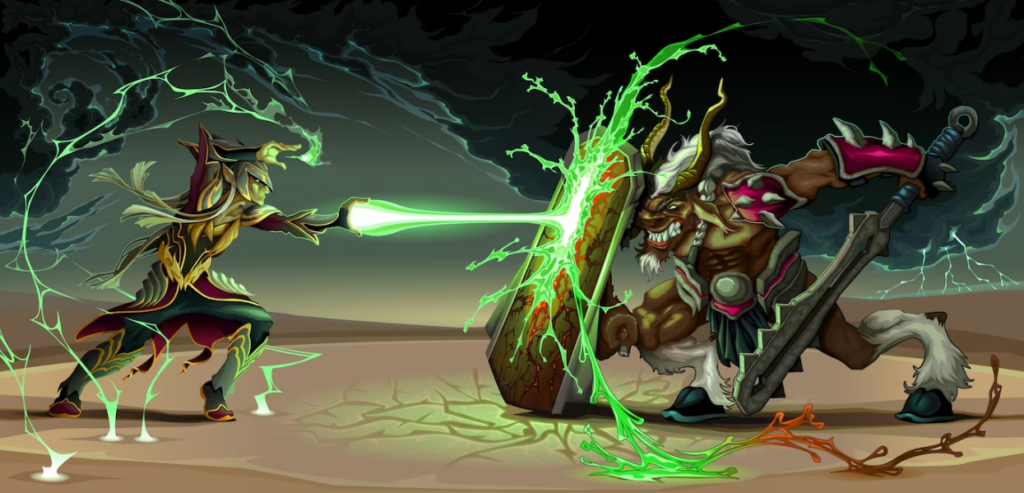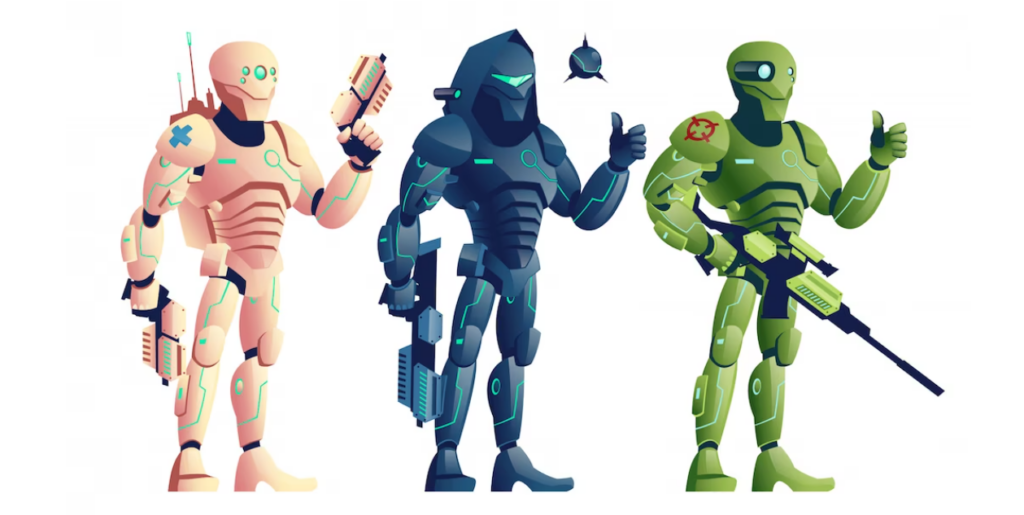
The Power of Pixels: Designing Dynamic Game Characters
Design in video games plays a pivotal role in creating memorable and engaging gaming experiences. From the heroes players control to the villains they face, well-crafted characters bring the virtual worlds to life. In this text, we will explore the different types, classes, and characteristics of design in video games.
A remarkable video game transcends beyond its captivating story, enjoyable gameplay, and imaginative levels. Without well-crafted characters, these elements would lose their impact. The true magic of a gaming experience lies in the seamless integration of all its components, with characters occupying a central role. In the collaborative realm of video game development, teamwork is essential for bringing characters to life. Game designers and writers work together to create compelling stories, delving into their motivations. Then, concept artists meticulously craft initial sketches, skillfully incorporating digital art elements. Not too long ago, characters were introduced to the world in pixelated cartoon forms. However, with the rapid advancements in technology, particularly in recent years, two-dimensional figures have evolved into extraordinary heroes. Today’s characters are masterfully constructed, boasting realistic components that have the power to evoke emotions.
Character Creation in Video Games: Designing Personalities
Character design in a video game is a crucial phase in the production process, where a game designer conceptualizes, styles, and creates the artwork for a character from scratch. This intricate process begins with the artist analyzing the character’s personality traits to breathe life into them. Character design can vary significantly between 2D and 3D games, as each type requires specific design requirements and characteristic considerations. Traditional 2D animation still holds its place as a more classical style, while 3D heroes players offer enhanced dynamism and fluid movement within video games.
Character design is one of the most vital aspects for video game development companies. Those responsible for this task must possess talent, intuition, honed skills, and a heightened level of creativity. Game artists work diligently to ensure that characters seamlessly blend into the game’s fantasy world. They establish unique personalities and create visual aspects that accurately convey the characters’ physical attributes.
The design process encompasses various elements, incorporating principles, theories, and execution within the drawing process. Through character design, the creative team guides the game’s story toward recognizable player interactions and generates emotions and immersion. Simultaneously, characters must be visually appealing, allowing players to identify and connect with them. Furthermore, during the development and game design stages, the team must consider the target audience, the context in which the characters will be used, and the available technology to create top-tier characters.

Exploring the Variety: Types and Classes of Characters in Video Games
In video games, various types and classes of characters are commonly found, each serving a specific role or function within the game’s mechanics and narrative. Here are some of the common types and classes of video game characters:
| Character Type | Description |
|---|---|
| Protagonist/Main Character | The central character controlled by the player, driving the game’s story and progression. |
| Antagonist/Villain | The primary opposition to the protagonist, creating conflict and serving as the main source of challenge and obstacle. |
| Supporting Characters | Characters that assist or accompany the protagonist, providing guidance, information, or additional abilities to contribute to the story and gameplay experience. |
| Non-Playable Characters | Characters controlled by the game’s AI, interacting with the player and fulfilling various functions such as quest-giving, trading, or adding depth to the game world. |
| Heroes/Champions | Characters with exceptional abilities, often associated with fantasy or superhero-themed games, possessing unique powers or skills that make them stand out. |
| Sidekicks/Companions | Characters who accompany and assist the protagonist, offering additional gameplay mechanics or emotional support. |
| Bosses | Powerful adversaries that serve as major challenges at specific points in the game. Defeating them usually progresses the story or unlocks new areas. |
| Minions/Enemies | Lesser foes that the player encounters throughout the game, providing regular combat encounters and obstacles to overcome. |
| NPCs in the Game World | Characters who populate the game world, adding life and atmosphere. They may have their own routines, dialogues, and roles within the game’s universe. |
| Playable Races/Factions | In games with extensive character customization or role-playing elements, different races or factions offer distinct abilities, backgrounds, and storylines for players to choose from. |
| Classes/Archetypes | In role-playing games, characters often fall into specific classes or archetypes, such as warriors, mages, rogues, or healers, each with their own unique set of abilities and playstyle. |
| NPCs in Multiplayer Games | In multiplayer games, NPCs can serve as allies, enemies, or neutral entities, providing additional interactions and challenges for players. |
The Secrets of Successful Character Design
Character design is not just about creating visually appealing characters; it is a vital aspect of visual storytelling in video games. It goes beyond aesthetics and delves into capturing the essence of a character, bringing them to life in a way that resonates with players. The process begins with a deep understanding of the character’s personality, motivations, and backstory, often provided through a writer’s brief or script. As a character designer, you play a pivotal role in translating these descriptions and ideas into visual representations.
Your task is to breathe life into these characters, giving them form, identity, and a unique visual presence. You must carefully consider their traits, physical attributes, and even their body language to accurately convey their personality and emotions. It is through your artistic interpretation and creative skills that these characters truly come alive on the screen.
Character design is a collaborative process that requires a keen eye for detail, an understanding of narrative, and the ability to effectively communicate with the rest of the development team. By visualizing the characters, you contribute to the overall storytelling experience, enhancing the immersion and engagement of players.
Achieving good character design entails a focus on clarity and attention to several key elements:
- Style/Tone: The character’s visual style should align with the overall tone and aesthetic of the production. Consistency is essential, ensuring that the character’s design fits seamlessly into the intended artistic direction;
- Costume: The character’s attire should be authentic and reflective of their personality, background, and narrative. It should also be coherent with their environment, making them visually cohesive with their surroundings;
- Posture: The way a character holds themselves should be in harmony with their personality and demeanor. Their posture can communicate important information about their confidence, mood, and intentions;
- Story: Understanding the character’s role in the storyline or scene is vital for effective design. Their visual appearance should support their narrative purpose, conveying their place in the overarching story;
- Silhouette: A strong character design is recognizable even in silhouette. Stripping away intricate details, the character’s silhouette should remain distinct and easily identifiable. Think of iconic characters like Mickey Mouse, whose simple silhouette is instantly recognizable.

A Step-by-Step Guide to Creating Character Designs
Step 1: Conduct Research
Immerse yourself in the world of your characters. Study relevant references, observe real-life counterparts, and understand their visual and behavioral traits. By delving into the subject matter, you can ensure authenticity and capture the essence of your characters.
Step 2: Gather Reference Images
Collect a range of reference images to inspire your character design. Even if your characters reside in a fantastical realm, reference images can provide valuable insights into mood, setting, and thematic elements. Let these visuals spark your imagination and guide your creative choices.
Step 3: Understand Your Audience
Consider your target audience’s preferences and expectations. Tailor your character design to resonate with their interests and sensibilities. Aligning your vision with their perspective enhances the connection and engagement between the audience and your characters.
Step 4: Develop Non-Visual Characteristics
Go beyond the visual aspects and define your character’s personality, backstory, and motivations. Craft multi-dimensional characters by incorporating unique traits, flaws, and aspirations. This depth adds believability and richness to their portrayal.
Step 5: Conceptualize
Translate your research and character development into rough concept sketches. Focus on capturing the key physical features, postures, and attributes that define your characters. Experiment and iterate to refine their visual representation.
Step 6: Establish a Color Palette
Choose a well-considered color palette that complements your character’s design and aligns with the overall visual style. Select a primary color and supporting colors that enhance the character’s personality and evoke the desired emotions.
Step 7: Refine and Detail
With a solid foundation, begin creating more detailed sketches of your characters in their intended style. Explore various angles, poses, and expressions to fully showcase their range. Pay attention to relevant props, costumes, and contextual details to enhance their visual storytelling.
Conclusion
The process of creating character game design is a fascinating and intricate journey that requires a combination of artistic skill, creativity, and an understanding of storytelling. By following the steps outlined in this tutorial, you can embark on this journey with confidence and create characters that leave a lasting impact on players. Understanding your audience and their unique perspectives enables you to tailor your character designs to resonate with them, forging a strong connection and enhancing their gaming experience. By delving into the non-visual characteristics of your characters, such as their personalities, backgrounds, and motivations, you create multi-dimensional and relatable individuals that players can truly invest in.